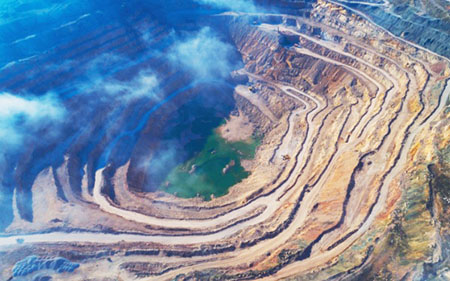by WorldTribune Staff, September 26, 2023
Researchers found that toxic byproducts from mining for minerals used in “green” energy have had devastating impacts on 23 million people worldwide, as well as 5.72 million livestock, over 16 million acres of irrigated farmland, and over 297,800 miles of rivers.

The toxic runoff is coming from mines which provide the rare earth elements which are essential to the manufacture of high-tech electronics, solar cells, wind turbines, and all the batteries needed to store sustainable “green” energy (and power electric cars and iPhones).
“Rapid growth in global metal mining is crucial if the world is to make the transition to green energy,” noted Chris Thomas, a zoologist at the University of Lincoln who led the analysis and modelling work for the new study, which was published on Sept. 21 in Science.
The devastation from the toxic byproducts, according to the study, was widespread. Affected are approximately 297,800 miles (479,200 km) of river systems total and over 63,000 square-miles (164,000 sq-km) of floodplains worldwide.
North America is the most affected, at 123,280 miles of tainted river systems, and approximately 10.7 million acres of polluted floodplains, the study said.
DailyMail.com noted in a Sept. 21 report that the researchers “developed a model to predict the spread of contaminants from all known active and inactive metal mines — plus facilities used to seal off hazardous mining waste — with a focus on pollution from lead, zinc, copper, and arsenic. These potentially harmful contaminants and industrial byproducts can seep into the local water supply, whether transported downstream where the metals are deposited along river beds and floodplains, or otherwise sinks deep into underground aquifers.”
The MIT Environmental Solutions Initiative said that green energy technologies like wind turbines and electric vehicles often require many more mined minerals than the present fossil fuels infrastructure.
One electric car, for example, requires six times more metallic and mineral materials than a combustion engine car, MIT’s university team reports. A wind power plant requires nine times more of these mined compounds than a traditional gas-fired plant.
The researchers also had harsh criticisms for “the environmental legacy of historical mining,” which they said was “most problematic in western Europe,” where long-abandoned old mines have left lasting environmental damage.
While the new study focuses on environmental impacts, global metals mining has recently faced lawsuits against major tech firms, including Apple, Google, Microsoft, and Tesla, over child slavery in the Congo, where 70 percent of the industry’s cobalt is sourced.
Please Support Real Journalism
Hello! . . . . Intelligence . . . . Publish
